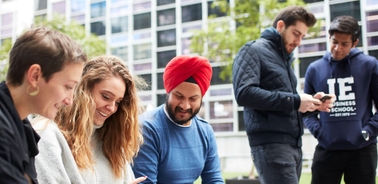- Home
- Blue Talks
- What Hyper-diversity Means In Higher Education
What hyper-diversity means in higher education

IE’s three-pronged approach to diversity goes far beyond narrow concepts.
By: Diego del Alcázar Benjumea
We refer to IE University as a hyper-diverse environment. At a simple glance, one can see why: we have students from more than 140 nationalities, we ensure demographic balances within our staff and actively engage with the community to bring different cultures and standpoints together. A global mindset is integrated into our culture and curriculums.
We live and breathe diversity. Not because it’s trendy or a box we are expected to tick off, but because it creates the ideal learning environment for students looking to foster positive change, and because it helps research thrive. Academic institutions play a powerful role in shaping both societal and individual outcomes.
IE goes beyond a narrow concept of diversity. Our hyper-diversity means much more than bringing people from different backgrounds together, although that is the pillar upon which our strategy rests.
While all frameworks are to some degree artificial, we can break diversity down into three main categories, as described by Celia de Anca and Salvador Arágon in an article published in Harvard Business Review.
First, we consider demographic diversity, which is tied to the attributes like gender, race, sexual identity, nationality, disabilities and other background traits. Experiential diversity based on life experiences that shape people’s interests, beliefs and points of view, is the second category we aim to foster. And last, but certainly not least, we have cognitive diversity — how people think and approach problems.
Fostering the three types of diversity in a university setting
For universities to create an environment with a truly diverse demographic mix, it’s not enough to just set admissions goals. If we take gender, for example, a detailed study has found that while women make up 54% of graduating students in universities around the world, they remain highly underrepresented in terms of academic positions, with women occupying just 36% of posts. Achieving demographic diversity is a process that requires setting clear objectives across the organization and closely monitoring progress on several fronts.
A university doesn’t stop at its walls, either. Academic research is a powerful tool, and we must seize on our unique opportunity to highlight diverse perspectives and promote positive change within society. We believe learning centers also have an obligation to engage with the community on the issues they believe in. From that commitment, we founded the Center for Diversity in Global Management to help make the business world more inclusive, created the GAPI tool to help eliminate gender bias and participate in research to monitor and boost diversity in Spanish companies.
In terms of experiential diversity, we support the unique passions of our students and staff through different initiatives, which are either institutional or student-run. We understand that a university is a place where strong bonds are formed. Over years of study, unique cultures emerge where many students end up with similar likes and dislikes. Often those cultures are based on a global mindset, and that we applaud.
But we still strive to foster diversity of experience. We encourage our students to actively participate in local impact projects on countries around the world where their knowledge can truly make an impact. In addition, we encourage interdisciplinarity in all that we do, pushing, for example, our computer science students to learn about humanities and our social science students to study technology.
While embracing cognitive diversity may often be overlooked, for us, it has proven to be fundamental. It’s all about acknowledging that everyone thinks differently and understanding that the most positive advances in recent years have been the result of teamwork. Collaboration succeeds precisely because everyone has a unique point of view, which allows diverse groups to find better solutions than lone wolves through colliding and combining ideas.
Being able to harness the power of the group is a skill that can be taught, learned and exemplified. It also involves designing experiences that reward a shift away from groupthink and towards constructive collaboration where risk-taking is encouraged and people feel comfortable being themselves.
To sum up our approach, I find it fitting to borrow from the beautiful words of IE student and poet Bubelo Mlilo: Diversity is the perfect manifestation of love and culture. Through it, we see the world from a different lens. Because of it, together we form a global muse.
We live and breathe diversity.
Being able to harness the power of the group is a skill that can be taught, learned and exemplified.